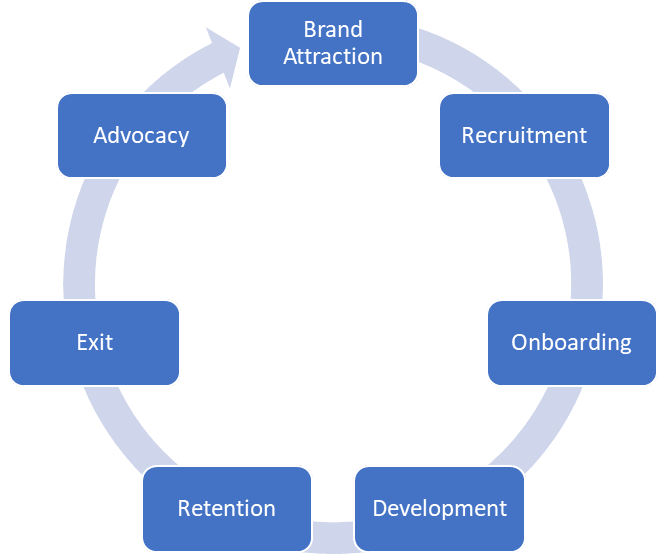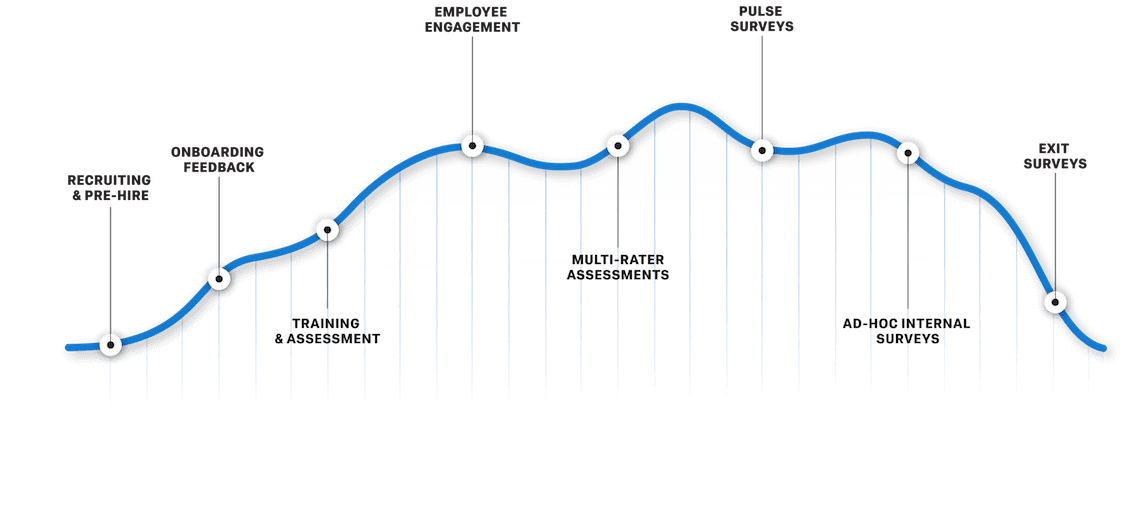What is the employee lifecycle?
Every employee goes on a journey, passing through specific stages in an organisation. It starts on the day they become aware of your company, right through to the day they leave. This is a proven model used in HR and People Team departments around the world known as the employee lifecycle model.
The employee lifecycle model (ELM) was inspired by customer journey mapping. If companies could measure and assess insights, impacts, issues, opportunities, and innovation successfully for customers, how powerful would such mapping be for employees? After all, employee experience is equally valuable as customer experience. The ELM is a visualisation method, used to track how an employee engages with their organisation at set stages of their employment.
Free eBook: Understanding Employee Lifecycle Feedback
Why design an employee lifecycle strategy?
When you analyse every employee’s lifecycle with the same care and accuracy that you map customers’ journeys, actioning the data you uncover, you’ll find significant benefits:
- You’ll be able to retain your top talent
- Your brand reputation will improve
- It is easier to recruit new talent
It’s a huge, expensive job to build company reputation and recruit people. When you find a way to retain your employees, and your brand’s reputation grows organically, you can direct the resources you saved in those areas to other parts of the business.
Download our eBook: Your Guide to Employee Lifecycle Feedback
The 7 stages of the employee lifecycle
The classic employee lifecycle model has five stages or phases:
- Recruitment
- Onboarding
- Development
- Retention
- Exit
However, we think two more stages need to be added: Brand attraction at the beginning of the lifecycle, and Advocacy at the end:

1. Brand attraction
Who hasn’t walked past a famous organisation, or used a great product, and thought, “I wish I worked for them”? We think the employee lifecycle should start at the point where we notice a brand, have a positive experience with it, and consider a career there. So, building a great brand, with the right image, true to your mission, vision, and values, and ideally one that hits the heights of brand equity, will attract the best candidates to your business.
KPIs and metrics for Brand Attraction: You’ll need to pull out all of your brand tracking metrics to make sure your brand is being the best it can be (but you’re probably doing that anyway).
2. Recruitment
This covers all the steps which lead to hiring a new employee. It starts with the initial job ad, and your website, which should demonstrate what your organisation does, its purpose and brand. And to attract the best, you’ll need a killer employer value proposition (EVP). An EVP is the package offered to current employees and potential job applicants that makes you a desirable employer. A good EVP outlines:
- Opportunity: How employees can grow and develop their careers at your organisation
- People: How good the leaders, managers and colleagues are, and the general working atmosphere
- Organization: The company’s prestige and its culture as a ‘great employer’ in its particular market
- Work: How meaningful, challenging and fulfilling the job is
- Reward: The salary, bonuses or share options, and perks
KPIs and metrics for Recruitment: Listening to social media, checking job sites such as Glassdoor and acting on feedback is essential to understand how your recruiting process is working. Ask candidates for feedback, using pre-hire surveys on the job ad, and application and interview processes. You can also calculate time to hire, cost per hire, offer acceptance rate, quality of hire, hiring diversity, and candidate experience.
3. Onboarding
This stage covers the new hire’s first day in the job, and the time they take to get up to speed with the tools, systems, processes and expectations in the role (‘ramp time’), to full productivity. It makes sense for this to be as short as possible and training to be efficient and effective. As new hires make their own niche and forge new relationships, they’ll need training and support – for up to a year if necessary.
KPIs and metrics for Onboarding: Onboarding and training surveys will identify where new hires found the process easy or difficult. Measure ramp time, new hire engagement, training effectiveness, and new hire turnover (how soon they leave, if they do).
4. Development
When your company encourages ongoing professional development, teams become smarter and happier. Individual employees develop at different rates and across a variety of competencies. It pays to encourage external learning and let employees develop with their own professional action plans. Development also includes how productive an employee is, how they interact in a team, and how they are trained and promoted, and their job satisfaction.
KPIs and metrics for Development: These include sales figures, training costs, productivity, 360 feedback, always-on employee feedback, promotion rates (are enough employees being promoted?) and training feedback.
5. Retention
Employees are fully ramped and integrated into the company. Now the goal is to keep them – performing, developing and contributing to your business’s success. Invest in retaining your top talent, because it’s much less expensive to retain your current people than recruit new ones. Any weak areas in training will become obvious by this stage, as will outstanding employee performance, and you will be able to identify employees who deserve promotion.
KPIs and metrics for Retention: A positive company culture is an absolute must for keeping people. It’s essential to run regular engagement surveys to gather employee feedback, and even more essential to act on the findings. Beware of over-surveying, leading to survey fatigue, though. And keep an eye on your turnover rate – why are people leaving and what can you do about it?
6. Exit
We have to accept that employees do leave, for a whole host of reasons, including retirement, a new position, education or personal reasons. You’ll probably get your most honest feedback at the exit interview, a vital, but too often botched stage in the employee lifecycle.
KPIs and metrics for Exit: You use this stage to understand why people are leaving the organisation so you can jump in to make improvements in the retention stage to reduce your attrition rate. Conduct exit surveys in a professional manner to demonstrate you’re still listening and caring; insights gathered here can ripple across all the lifecycle stages and provoke action. Have a process in place to learn from the feedback, and maintain good team morale when someone leaves.
7. Advocacy
In an ideal world, the employee experience across the whole lifecycle should be so good that every exiting employee will remain an active brand ambassador. Employees whose exit experience is positive are nearly three times as likely to recommend their organisation than unhappy or neutral ones.
Unhappy departing employees, on the other hand can:
- damage your employer brand
- affect your ability to recruit top talent
- disrupt team morale
- damage reputation with customers
KPIs and metrics for Advocacy: Make sure that exiting employees feel heard, you thank them for their service, and make them feel proud of their contributions. Set up a company alumni scheme (similar to one universities use) to network with former employees. Alert them to company news, new employment, or referral opportunities – personal recommendations are an effective (and cheaper) way to recruit great people and foster collaboration.
Optimising your HR KPIs through lifecycle feedback
The various KPIs at every stage in the lifecycle are how you demonstrate value to leadership and make the link between your HR initiatives and the core financial or operational metrics of the organisation.

But how do you improve the KPIs at each stage? The answer lies in having an employee lifecycle management program so you can collect feedback at every stage and analysing it as a holistic data set. This allows you to map out the experience for employees from interview to exit and identify the relationships between the different activities at each stage.
While each stage has its own KPIs, they’re all interdependent, with each one having an impact on KPIs in the same and different stages in the lifecycle.
Take ramp time as an example, a shortened ramp time is not only going to have the obvious impact on productivity but will affect engagement too. Similarly, an increase in employee engagement has been shown to reduce attrition and increase productivity.
Viewing these KPIs in silos risks underestimating their impact on the organisation’s core operational metrics. But when viewed together as a holistic data set, HR teams can start to see the combined impact of improvements across the lifecycle and identify which actions will have the biggest impact on the business as a whole.
While there are best practices templates for all mechanisms of employee feedback, there are no hard and fast rules about when to gather feedback – essentially, if it matters to your employees, it’s a good opportunity to gather feedback.
Free eBook: Understanding Employee Lifecycle Feedback